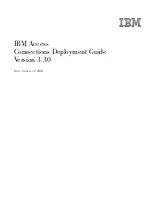
13.
Connection
status
Saving
location
profiles,
settings,
time,
and
reducing
help
desk
calls
Create
location
profiles
with
nearly
all
the
settings
you
need
to
connect
almost
anywhere
that
network
connectivity
is
available.
After
profiles
are
set,
Access
Connections
lets
you
easily
switch
between
them.
Profiles
can
be
set
for
automatic
switching
between
wireless
and
wired
connections
based
on
the
highest
available
compatible
connection
speed.
They
can
be
set
to
change
default
printers,
turn
on
a
VPN,
or
launch
applications
by
location.
Plus,
Access
Connections
helps
manage
wireless
security,
including
Wi-Fi
Protected
Access,
WEP,
802.11x
and
Cisco
LEAP.
Profiles
can
also
be
centrally
managed
to
simplify
deployment.
IBM
Access
Connections
software
is
included
with
the
purchase
of
every
new
IBM
ThinkPad
®
notebook
system.
A
list
of
ThinkPad
models
that
are
compatible
with
IBM
Access
Connections
can
be
found
at
http://www-
306.ibm.com/pc/support/site.wss/migr-4zlnjb.html#ac.
There
are
many
other
software
utilities
available
today,
typically
included
with
network
adapters,
that
appear
similar
in
function
to
Access
Connections
software.
Utilities
such
as
Intel
®
PROSet
and
the
Cisco
Aironet
Client
Utility
(ACU)
both
provide
profile
switching
capabilities
that
control
configuration
and
management
for
their
associated
WLAN
adapters.
Access
Connections
software,
however,
manages
a
much
more
extensive
collection
of
hardware
adapters
including
LAN,
WLAN,
WAN
(wide
area
network
or
cellular),
dial-up,
as
well
as
Ethernet-connected
broadband
(DSL,
cable,
ISDN).
Supporting
all
of
this
networking
hardware
provides
a
key
benefit:
Access
Connections
software
eliminates
the
need
for
administrators
to
learn
and
manage
multiple
client
configuration
utilities.
All
WLAN
configuration
utilities,
as
well
as
the
built-in
capability
in
Microsoft
®
Windows
®
XP,
enable
you
to
create
profiles
with
settings
for
network
name,
SSID,
and
security
setup,
including
the
definition
of
a
wired
equivalent
privacy
(WEP)
key.
However,
only
Access
Connections
software
integrates
location-specific
control
over
the
networking
and
Internet
settings
that
are
traditionally
set
through
multiple
facilities,
windows,
and
utilities
in
Windows.
These
include:
v
Fixed
IP
address
or
dynamic
host
configuration
protocol
(DHCP)
v
Auto
domain
name
system
(DNS)
or
explicit
DNS
addresses
and
DNS
suffixes
v
Internet
Explorer
(IE)
home
page
and
proxy
settings
v
Enable/disable
file
and
printer
sharing
v
Internet
connection
firewall
v
Windows
default
printer
v
Auto
launch
virtual
private
network
(VPN)
of
choice
v
Auto
launch
of
any
other
executable
Without
Access
Connections
software,
users
might
need
to
take
significantly
more
steps
to
set
up
a
network
connection
in
a
location.
For
example,
consider
a
telecommuter
who
uses
an
Ethernet
connection
both
at
work
and
at
home.
At
work,
the
user
is
required
to
use
a
fixed-IP
address
with
explicit
DNS
settings
and
a
proxy
server
for
Internet
browsing.
But
at
home,
the
cable
modem
dynamically
assigns
an
IP
address
(DHCP
mode)
and
the
user
does
not
need
explicit
DNS
settings
or
a
proxy
server.
To
use
the
notebook
at
home,
the
user
must
modify
Windows
network
properties
to
enable
DHCP
and
automatic
DNS.
And
the
user
must
also
turn
off
the
proxy
settings
in
IE
tools
options
or
the
Internet
will
be
inaccessible.
4
IBM
Access
Connections
Deployment
Guide
Version
3.3.0
Содержание IBM Access Connections 3.3.0
Страница 1: ...IBM Access Connections Deployment Guide Version 3 3 0 Date October 11 2004 ...
Страница 4: ...iv IBM Access Connections Deployment Guide Version 3 3 0 ...
Страница 6: ...vi IBM Access Connections Deployment Guide Version 3 3 0 ...
Страница 16: ...10 IBM Access Connections Deployment Guide Version 3 3 0 ...
Страница 26: ...20 IBM Access Connections Deployment Guide Version 3 3 0 ...











































